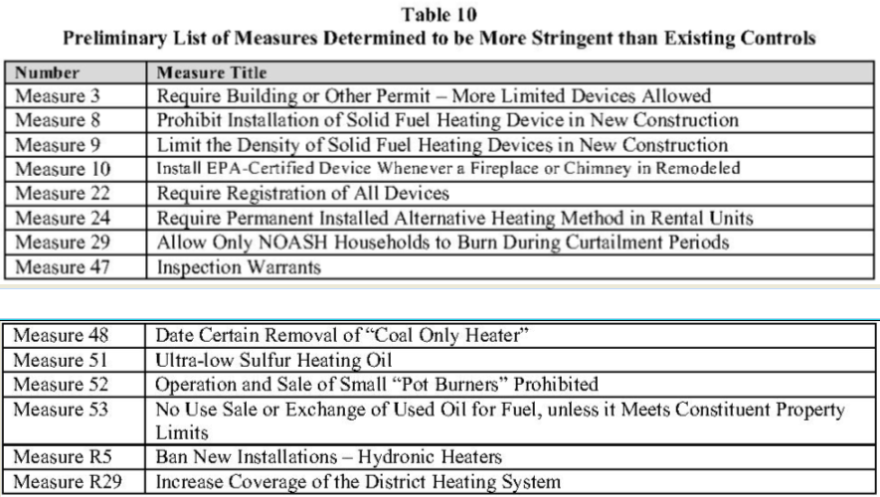State air-quality regulators told local officials and about 50 members of the public Tuesday that the Fairbanks North Star Borough soon will have to impose a new set of tough measures to dramatically reduce fine particulates and other air pollutants in the Fairbanks area. The new measures will affect just about everyone in the area – not just those who burn wood for heat.
The regulators with the state Department of Environmental Conservation’s Air Quality Division delivered a sobering message in Tuesday’s meeting at the borough Assembly’s chambers.
“Unfortunately, to some extent, we’re not here as the bearer of good news tonight,” Air Quality Division Director Denise Koch said.

Koch says the panel of agency air-quality experts requested the meeting to explain a set of documents they’d produced that lay out the measures needed to reduce the area’s air pollution so that it won’t harm human health and will bring the borough back into compliance with federal air-quality standards.
“This is a preliminary draft,” she said. “We are showing you documents because we want you to see our early thinking. We need your input.”
The panelists focused much of their presentation on 14 proposed measures that are more stringent than the borough’s existing efforts to reduce fine particulates, or PM2.5, which have mainly focused on homes with woodstoves. They said federal law requires more-stringent measures because the borough had failed to reduce PM2.5 around Fairbanks and North Pole sufficiently to attain federal air-quality standards.

So, the Environmental Protection Agency last year redesignated it a serious non-attainment area, and required the state to develop a plan that includes such measures as mandatory use of ultralow-sulfur heating oil, or ULSD.
“ULSD is being looked across the community, wholesale,” said division Program Manager Cindy Heil. “ULSD across the board – everybody. Homeowners, business owners, everybody.”
Heil says DEC estimates ultralow-sulfur heating oil would cost 34 to 43 cents a gallon more than No. 1 and No. 2 heating oil. But ULSD greatly reduces sulfur emissions, says Bob Dulla, who was contracted by DEC for the analysis.
Dulla says number-one fuel oil emits about 850 parts per million of sulfur when burned. That’s more than 50 times the 15 parts per million that burning ULSD produces.
“It’s a very, very significant reduction, and provides a very real benefit,” he said.

Heil says the State Implementation Plan that DEC is compiling also will likely require reducing emissions of sulfur dioxide, because the chemical compound can combine with other substances in the atmosphere and form PM2.5. So, she says, DEC proposes to require owners of so-called point sources of emissions, mainly powerplants, to install a total of $54 million worth of additional pollution-control technology to remove most of their sulfur-dioxide emissions.
“There are other control measures on the point sources for sulfur that have higher efficiency rates,” she said, “but as you can see one (costs) $103 million and the other is $160 million.”
Heil and the others emphasized that they’ve tried to balance the costs of the measures they’re proposing in the State Implementation Plan against the benefits. But she and the other panelists warned there’s no guarantee that EPA won’t require more stringent measures that for example could include the more efficient powerplant-emissions control technologies.
On the other hand, as Dulla said, they’re all aware that at some point, at least some residents may decide they can’t afford to pay the cost of cleaner air.
“Everybody knows if the price goes up, you’re going to use less of it, or you’re going to search for alternatives,” he said. “And in this case, the search for alternatives turns out to be really important, because one of the most likely candidates as an alternative is burning more wood.”
Assemblyman Van Lawrence came back to that issue during a question-and-answer period after the panelists spoke, and suggested the state plan should account for those possible tradeoffs.
“We also have to figure out how much PM2.5 is being generated by that increase in wood-burning, as compared to how much is being saved by decreasing the amount of sulfur in the air,” Lawrence said.
Other Assembly members and officials at the meeting raised other concerns, such as how higher fuel-oil prices will affect the Interior Gas Utility’s efforts to encourage conversion to natural gas.
By the end of the meeting, most appeared ready to get to work on ordinances that would implement DEC’s proposed measures. Borough Mayor Karl Kassel says he’ll begin by immediately forming a stakeholders group to include residents and representatives of businesses that would be affected by the new regs, such as Golden Valley Electric Association.
“This is a communitywide problem, and everybody in the Fairbanks North Star Borough is going to be impacted by this,” Kassel said. “It’s an issue that doesn’t have an easy solution. And any of the solutions are going to involve the entire community to get there.”
Koch, the Air Quality Division director, says she and the other panelists will meet today with some of those stakeholders, including Golden Valley.



